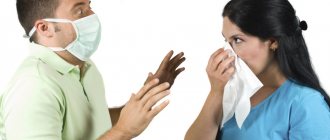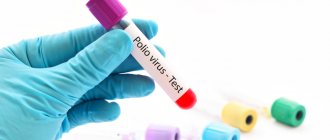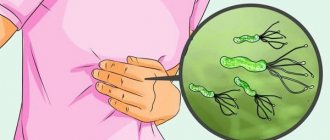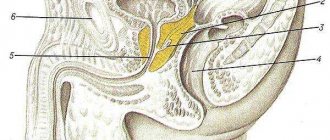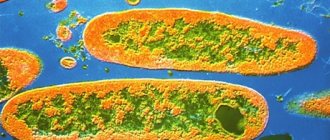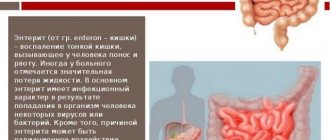If treated improperly or not, colds can be complicated by pneumonia or bronchitis. A cold is essentially an inflammation of the mucous membranes that are “infected” with viruses. Typical symptoms of cold viral diseases are:
- runny nose;
- frequent sneezing;
- feeling of general malaise;
- a sore throat.
In addition, the paranasal sinuses and ears may be affected, which can result in the onset of sinusitis or otitis media. Sometimes a cold is mistaken for the flu because their symptoms are very similar. But if in order to quickly cure a cold you need to stay in bed, drink a lot of warming drinks, drink echinacea for immunity, take cold powder, then with the flu everything is much more complicated...
Popular about ARVI
This category of viral infection refers to a group of diseases that affect the respiratory system, spreading through the air (airborne) or through bodily contact. Most often, people who have a low immune status suffer from it.
An acute viral infection has the ability to spread quickly in places with high crowding of people (in kindergartens, schools, work collectives).
At the time of seasonal exacerbation, it can develop in 30% of the population.
Despite the fact that acute respiratory viral infections and acute respiratory infections have a similar clinical picture, these are two different pathologies. Since the provoking factor for the occurrence of acute respiratory infections can be both viral and bacterial microflora. In the pathogenesis of ARVI, only the virus is present.
List of drugs for ARVI and their inexpensive analogues
Tablets, medications necessary for quick relief from the unpleasant symptoms of ARVI, are prescribed from the first day of illness. Most common medications are expensive, which is quite expensive.
However, many well-known drugs have equally effective, but much less expensive, analogues:
- Aspirin is replaced with acetylsalicylic acid;
- Otrivin, Xymelin, drops containing acidometazoline have an analogue Galazolin;
- instead of the expensive immunomodulator Immunal, you can drink echinacea tincture;
- an excellent analogue of Lazolvan, Ambrobene, is Ambroxol;
- to lower the temperature and get rid of headaches, it is not necessary to take expensive Nurofen or Panadol, you can take Ibuprofen and Paracetamol;
- It is possible to increase the body's resistance to viral activity by introducing interferons into the body not only with the help of Viferon suppositories, but also by using ordinary interferon alpha 2-b.
Causes and factors that contribute to the development of viral infection
In the pathogenesis of the development of ARVI, the main role is played by viral pathogens that penetrate the mucous epithelium lining the upper respiratory tract or the conjunctiva of the visual organs.
The main causative agents of infection are the following viruses:
- Influenza and parainfluenza;
- Adenoviruses and rhinoviruses.
There are also conditions and situations where the likelihood of developing a pathological process increases.
These include:
- Prolonged exposure to the cold, which causes general hypothermia of the body.
- Violation of the psycho-emotional state as a consequence of stressful situations.
- Failure to comply with the norms of rational food consumption leads to a decrease in the intake of vitamins, coarse fiber, and beneficial micro and macroelements in the body (the result of seasonal vitamin deficiency, the use of newfangled mono-diets).
- Negative environmental impact.
- Long-term course of other chronic processes.
- A decrease in the body’s defenses as a result of surgical therapy or after suffering serious illnesses.
List of antiviral medications for colds
The habit of Russians to delay treatment of influenza and to get sick on their feet leads to complications. About 40% of people with influenza are at risk of getting bronchitis, pneumonia, sinusitis, and less often - pyelonephritis, stomatitis and other diseases. Therefore, the appearance of chills, runny nose and other symptoms that resemble the flu should be a signal for the sick person to begin treatment.
- Tamiflu. This drug is based on Oseltamivir. Prescribed for the need for the prevention and treatment of influenza in patients of different age categories.
- Grippferon. This is an effective medicine for diseases such as ARVI and influenza. The main active ingredient in its composition is Interferon alfa-2b. It is allowed to be taken if you are prone to allergic reactions and individual intolerance to the components of the drug.
- Relenza. The main active ingredient of this drug is Zanamivir. Helps cure infections caused by influenza virus type A or B.
- Amiksin. This drug contains Tiloron. The medicine is recommended if it is necessary to treat viral hepatitis A, B and C, as well as cytomegalovirus and urogenital infections, ARVI and influenza.
- Kagocel. This is a medicine that effectively treats and allows for the prevention of herpes, ARVI and influenza. Suitable for patients of adult and pediatric age categories.
- Arbidol. The drug is an effective medicine in the treatment of diseases such as influenza A and B virus, its subtypes H1N1, H2N2, H3N2 and H5N1. In addition to this, it rids the body of some other pathogens of ARVI (coronavirus, adenovirus, etc.).
Incubation period and primary signs of viral infection
The latent period, its second name is hidden, can last up to 10 days, but usually the disease develops in the interval from 3 to 5 days.
A patient infected with a viral infection releases painful microbes into the environment within a day from the moment of clinical manifestations. Therefore, he becomes a carrier of infection without knowing it.
The first harbingers of the development of a viral infection in an organism can be:
- The appearance of a cutting or burning sensation in the eyes, which is accompanied by copious secretion of tears.
- There is a gradual increase in body temperature.
- There is mucous discharge from the nasal passages, they become irritated, and sneezing occurs.
- Swelling of the lymph nodes occurs.
- An incipient cough does not allow you to rest at night.
- A sore throat may be accompanied by hoarseness.
In this case, the patient must be isolated (assigned a separate room), and the following measures must be taken to avoid infecting others and family members:
- When communicating, be sure to wear a gauze mask.
- Personal hygiene items must be strictly individual, this also applies to cutlery.
- Be sure to wet clean the room using disinfectants.
- For the patient, bed rest will be optimal.
Transmission routes
The source of a viral infection is always a sick person, and he may not even realize that the infection has already entered his body. The maximum amount of virus in the human body necessarily comes out, penetrating to other people.
Infection can occur in the following ways:
- during a conversation;
- when coughing or sneezing;
- after a sick person touches objects or objects of general or individual use.
Under environmental conditions, as well as full compliance with personal hygiene measures, viruses practically do not live.
Not every person can become infected with a viral infection; some can catch it and carry it for a while without developing acute symptoms. It all depends on the strength of a person’s immunity and his state of health.
Clinical symptoms
The clinical picture of the development of ARVI requires adequate therapy, and various symptoms may occur.
The disease can develop either gradually or rapidly, and the sooner the disease is detected and the treatment process begins, the lower the chances that the pathological process will lead to the development of complications.
The main signs of the development of a viral infection, necessary actions, situations requiring emergency care.
| Clinical symptoms of viral infection | Necessary actions |
Common symptoms that occur after a patient becomes infected are:
| This condition necessitates a visit to a medical facility for an appointment with a therapist or ENT doctor. |
| If the clinical picture does not go away within 10 days, then additional symptoms may occur. Most often observed:
| Go to the hospital again, or call a doctor at home. There is a need to adjust treatment measures. |
The following symptoms are particularly dangerous:
| The development of such a situation requires an urgent call to a mobile ambulance team. This is due to the fact that the patient is indicated for hospitalization, followed by treatment in a hospital setting. |
Antibiotics
Antibiotics are often used by people far from medicine to speed up their own recovery during a viral attack. However, this approach is considered completely erroneous, because antibacterial drugs only affect bacteria, without having any effect on viruses.
Moreover, such an effect on the body will put unnecessary stress on the liver, which will only prolong the healing process.
The use of antibacterial medications is justified when ARVI drags on and bacterial infections are added to the virus, causing a deterioration in the person’s condition.
What signs can be used to determine the occurrence of complications?
- The patient's condition worsened, the temperature increased to 39 degrees, after a short-term improvement.
- The appearance of severe pain in the throat, head, chest.
- The occurrence of severe cough, shortness of breath.
- Discharge of purulent mucus from the nasal cavity.
Why do complications develop? This process can be triggered by a number of prerequisites:
- failure to comply with doctor-recommended bed rest;
- weak immunity;
- treatment not started in a timely manner;
- history of chronic diseases (diabetes mellitus, pathologies of the cardiovascular system);
- recent surgery;
- old age or infancy.
Complications of ARVI include the occurrence in some cases of infectious diseases :
- bronchitis;
- pneumonia;
- sinusitis;
- sinusitis;
- tonsillitis;
- frontal sinusitis;
- otitis.
When a person is attacked by a virus, his body is greatly weakened, so harmful bacteria begin their active impact, affecting those organs that are weakest.
Possible consequences in the absence of proper therapy
If for some reason the treatment process to eliminate a viral infection does not occur in full, or in violation of medical recommendations, the risk of complications increases significantly.
They may be:
The development of inflammation processes localized in the paranasal sinuses (sinusitis, sinusitis or sinusitis).- The spread of infection through descending routes causes the formation of bronchitis or pneumonia.
- Very often, a focus of inflammation develops in the Eustachian tube with the development of otitis media.
- With weakened immunity, a secondary bacterial infection occurs, which is manifested by the development of sore throat.
- If the patient has been diagnosed with bronchopulmonary diseases, they may worsen during this period, complicating the clinical picture.
Antibiotic for colds and flu
Antibiotics are rightfully considered the treasure of modern medicine. But their misuse can lead to severe consequences.
Antibiotics are commonly used to treat diseases caused by bacteria. People often mistakenly believe that they also work for viral infections such as colds or flu. But that's not true!
In the early days of the onset of illness, the body's natural immune response occurs, so when an antibiotic is used too early, the defense mechanisms that could control the infection on its own are suppressed.
It is for this reason that it is recommended to take immunostimulating antiviral agents, such as Oscillococcinum, a drug that naturally stimulates the immune system and affects the production of its own immunoglobulins. Oscillococcinum strengthens natural immunity against viruses, reducing the likelihood of getting sick by 6 times3.
So it is best to avoid antibiotics in case of flu and colds. They are effective only in the event of a bacterial infection. But you shouldn’t overdo it here either, because bacteria very quickly “learn” to resist antibiotics and can transfer this “knowledge” to each other. Bacterial resistance to antibiotics develops.
So, let's summarize the results of taking antibiotics:
- They are only effective against bacterial infections and cannot cure you of infections caused by viruses, such as colds or flu.
- Antibiotics do not prevent viruses from spreading to other people.
- Overusing these drugs only makes bacteria resistant to treatment, so if you or your children need antibiotics sometime in the future, they may no longer work.
- And most importantly: the inclusion of an antibiotic in the treatment regimen must be strictly agreed with the doctor.
Types of infections
Adenovirus infection
A variant of this pathogen causes disease by airborne transmission (aerosol or airborne transmission). The second route of spread is fecal-oral, which involves human infection through contact and household contact.
The hidden incubation period is no more than 15 days.
During this period, patients note a loss of strength, weakness and a feeling of weakness. Then, in adult patients, the following sequence of symptoms begins to be observed:
- Fever and chills appear, pain forms in muscle groups and joints.
- Difficulties arise in natural breathing through the nose.
- A whitish coating appears on the surface of the palatine tonsils, they become swollen and hyperemic.
- Nearby lymph nodes hypertrophy (enlarge).
The lack of therapeutic therapy leads to the occurrence of inflammation in the bronchi, trachea, and larynx.
In this case, the patient experiences:
- Hoarseness of voice.
- Boring cough without sputum production.
- Difficulty breathing (shortness of breath).
- Sore throat and pain when swallowing food.
This type of pathology is characterized by the fact that organ damage begins from the upper parts of the nose or mucous membranes of the eyes, with the subsequent movement of the inflammatory process to the respiratory organs and intestines.
Flu
The development of this pathological process is accompanied by a prodromal (hidden) period, the duration of which is 5 days. In some cases, it can be reduced to 2 days.
After this, the patient experiences the following symptoms:
- A sharp rise in body temperature, sometimes to critical levels (38 or 40 degrees).
- Muscle pain and joint aches occur.
- The resulting headache is accompanied by dizziness, with noise and ringing in the ear canals.
- A dry cough occurs, and as a result, pain appears in the chest.
- Upon visual examination, there is redness and swelling of the face, redness of the white part of the eye, and the skin becomes dry.
Adequate therapy eliminates these pathological manifestations within 7 to 10 days.
Clinical signs that necessitate calling an emergency medical team:
- If the temperature is 40 degrees and remains stable for 5 days.
- Localization of headache in the occipital region, inability to relieve pain with conventional analgesics.
- Severe shortness of breath with difficulty breathing.
- The appearance of delusions and hallucinations.
- The occurrence of seizures.
- Hemorrhagic rashes on the skin surface.
Parainfluenza
Unlike influenza viral infection, this pathology has a moderate clinical picture.
And therefore the disease progresses more easily. In rare cases, it may be complicated by the development of otitis media, sinusitis, tonsillitis or pneumonia. The most serious consequence is the occurrence of meningitis. The main symptoms of the clinical picture:
- The temperature does not exceed 38 degrees.
- A feeling of chills appears with an unpleasant sensation in the muscles and joints (the patient complains that they ache and twist).
- Breathing through the nasal passages is impaired, as they become blocked and mucus is released from them (a runny nose appears).
- The palatine tonsils become bright red, the voice becomes hoarse.
- The peculiarity of the cough is that it resembles a dog barking.
MS infection
Respiratory syncytial infection occurs due to the penetration of a special type of RNA virus that belongs to the group of paramyxoviruses.
The latent stage of the latent course can last from 3 to 7 days. In adult patients, this viral infection is mild.
At the same time, appetite, sleep and general condition usually do not suffer.
Main manifestations:
- The temperature rises to low-grade fever (37 degrees).
- There is pain in the head like a migraine.
- Nasal congestion is accompanied by slight mucous discharge.
- There is a soreness or slight tingling sensation in the throat.
- The cough is initially dry, gradually turning into wet.
The clinical picture is eliminated by effective therapy within 2 to 7 days, but the cough can remain from 10 to 20 days.
Flu vaccination: where to get it, side effects, whether an adult should get the vaccine
Doctors began talking about influenza vaccination as an effective means of preventing this disease a very long time ago. The flu shot may not always prevent infection, but it can relieve symptoms and help avoid complications.
If you get a flu vaccine, then the question of how to treat the flu will disappear for a long time
The drug is administered intramuscularly. For adults, the injection is given in the shoulder, and for young children, in the thigh. The vaccine is not given in the buttock, since it is very difficult to reach the muscles in this place and the drug can be injected into the subcutaneous tissue, which will not have the desired effect.
- Possible side effects:
- pain at the injection site;
- slight increase in temperature;
- fatigue;
- weakness and muscle pain;
- headache;
- itching at the injection site;
- there is redness or hardness at the injection site.
Should adults get a flu shot or not? This is a question many people ask.
And everyone makes their own choice, taking into account the pros and cons of vaccination.
Pros of vaccination:
- immunity to one or more types of influenza;
- if infection occurs, the disease will be mild and will not lead to complications;
- free vaccination at the clinic;
- strengthens the body's defense system;
- no age restrictions for adults.
Disadvantages of vaccination:
- the virus mutates and the vaccine may not be effective;
- possibility of an allergic reaction;
- availability of low-quality vaccines;
- examination before vaccination for allergic reactions and absence of signs of a cold.
Taking into account the pros and cons of flu vaccination, everyone makes a decision whether or not to get vaccinated.
Diagnosis of viral infection
Initially, a patient who is suspected of developing a viral infection should consult a general practitioner.
To make an accurate diagnosis, the following types of examination are performed:
The patient's complaints are listened to, followed by an external examination. The condition of the skin and pharyngeal tonsils is taken into account.- Immunofluorescence express diagnostics is prescribed.
- If necessary, bacteriological culture is performed.
- Consultations with related specialists (pulmonologist, otolaryngologist) may also be prescribed.
- Pathological processes in the ENT organs require pharyngoscopy, rhinoscopy or otoscopy.
- X-rays of frontal and lateral projections are prescribed if a complication in the form of pneumonia develops.
Features in elderly patients
The characteristics of different types of therapy may have different effects on different categories of people. It is especially difficult for people in adulthood.
Features of treatment for older people:
- mandatory intake of maintenance therapy, in the form of vitamin complexes, probiotics;
- careful prescription of antiviral therapy (only on the recommendation of a doctor);
- the presence of diseases of the kidneys, liver, heart and blood vessels, requiring close attention to the course of a viral respiratory infection with constant monitoring of changes in the condition of patients
Elderly patients can use drugs that stimulate the production of their own interferons: Arbidol, Amiksin, Cycloferon, Viferon. For the purpose of preventive action, immunomodulators (Immunal, Bronchomunal) should be used according to the regimen prescribed by the doctor.
Basic methods of treating viral infections in adult patients
Therapy for adult patients when a diagnosis of acute respiratory viral infection is established is carried out comprehensively, taking into account the individual characteristics of the body and the severity of the clinical manifestations of the disease.
The drugs of choice are antiviral agents. Other dosage forms are prescribed as symptomatic treatment.
Approximate treatment regimen using recommended drugs for acute respiratory infection of viral origin:
- Dosage forms that eliminate the activity of viral microflora. The most frequently prescribed medications: Grippferon . The main ingredient is recombinant human Interferon. It can be equally used both in the treatment and prevention of viral diseases. Use is not allowed in all trimesters of pregnancy, or when one of the components is an allergen for the patient.
- Amiksin . Prescribed as the main remedy for ARVI or influenza. In rare cases, it can cause allergic manifestations on the skin surface, an increase in body temperature or a feeling of nausea.
- Arbidol . Compared to other drugs, they have an advantage because they are able to increase the body’s immune status. The drugs have a minimal list of contraindications and side effects (an allergic reaction may develop due to intolerance to the main or additional component).
- Remantadine. The therapeutic effect occurs due to the destruction of the cell membrane of the viral envelope. Can be used for preventive purposes. Pregnancy, the period of feeding the baby with breast milk, impaired renal function and insufficiency in liver function, limit the scope of use of this dosage form.
- Altabor. A product of natural origin based on alder extract. In addition to the inhibitory effect on the development of viral infection, it is effective against bacterial microflora. It is not prescribed during pregnancy due to the lack of tests regarding the effect on the health of the unborn baby. Sometimes allergic manifestations may occur, which are a contraindication to the use of this medication.
Altabor
Amiksin
Arbidol
Grippferon
Remantadine
- Medicines that relieve the severity of inflammation due to non-steroidal action. This pharmacological group allows you to relieve inflammation, while eliminating pain and normalizing body temperature. For this purpose, the following is used: Nurofen.
- Diclofenac.
- Paracetamol.
Diclofenac
Nurofen
Paracetamol
- Drugs that block histamine production. With the development of a viral infection, they help eliminate swelling of the tissues of the mucous membrane lining the nasal passages and oropharynx. They make breathing easier and normalize the patient’s condition. They also help relieve redness from the white part of the eye. It should be used very carefully if the patient is diagnosed with cardiac pathologies. Preference is given to the latest generation drugs: Claritin.
- Zyrtec.
- Cetrin.
- Telfast.
Claritin
Tsetrin
Telfast
Zyrtec
- Medicinal forms that eliminate the feeling of heat at high temperatures . They are prescribed taking into account that the temperature must be brought down if it exceeds 38.5 degrees. It would be optimal to prescribe combination drugs based on Paracetamol. They compare favorably with drugs that contain acetylsalicylic acid. Because in some cases, aspirin and its analogues can cause pathological changes in the central nervous system and lead to liver failure. The following have a good effect: Anvimax.
- Grippoflu.
- Coldrex.
- Fervex.
Anvimax
Fervex
Grippoflu
Coldrex
- Medicines to relieve pain and sore throat. Their therapeutic effect is carried out due to the presence of antiseptics in the composition. They are easy to use, as they are available in the form of aerosols or tablets with a pleasant taste. In this case, the following will have a positive effect: Hexoral.
- Septolete.
- Lysobacter.
- Inhalipt.
Ingalipt
Lysobacter
Hexoral
- Medicines that eliminate cough . The main goal in the development of a dry cough is to ensure that it becomes moist and sputum begins to be discharged. The development of such a situation requires the appointment of: Ambroxol.
- Bromhexine.
- Mukaltin.
- Licorice syrup (have a natural base).
Ambroxol
Bromhexine
Mukaltin
Licorice syrup
- To eliminate the symptoms of a runny nose and restore natural breathing through the nasal passages, drops are used that provide a vasoconstrictor effect. Most often prescribed: Naphthyzin.
- Sanorin.
- Pinosol (if there is no allergic reaction to natural components).
Naphthyzin
Pinosol
Sanorin
- Vitamins and multivitamin complexes. They are prescribed to increase overall tone, as they strengthen the immune system and prevent the development of secondary infection. Positive dynamics have: Complivit.
- Centrum.
- Ascorbic acid.
Ascorbic acid
class=”aligncenter” width=”800″ height=”800″[/img] Complimentary
Antiviral therapy chemotherapy drugs
The main means of combating viral activity are interferons, protective antibodies produced by the body in response to an attack of infection. Normally, such substances are created in the right quantities by the human body; when they are not enough, pharmaceuticals that enhance the production of interferon come to the rescue.
In addition, there are means that do not allow viruses to develop and attack healthy cells of the body, thereby slowing down their activity and leading to the destruction of the infection.
Most common antiviral drugs
- Rimantadine: used to combat influenza virus type A. It has virtually no effect on other infections.
- Oseltavmir: allows you to reduce the manifestations of intoxication in the body, reduce the likelihood of developing complications of a bacterial nature. Prophylactic use of the drug helps protect a person from infection. The drug has minimal side effects.
- Ribavirin: applies only in cases where there is confirmation of viral activity obtained after appropriate diagnostics. The drug is not without side effects (insomnia, bronchospasms, psycho-emotional disorders, rashes and eye irritation).
- Pleconaril is used to get rid of rhinovirus. The medicine has not yet gone through all the stages of proving its high effectiveness, but is already being actively used, showing good results.
- Arbidol - tablets that actively fight the influenza virus. They are used not only for treatment, but also for the prevention of disease.
- Viferon: Delivers human-type interferons into the body, enhancing the human body's ability to fight the virus. Grippferon spray has similar properties, which is easy to use.
- Cycloferon and Amixil enhance the production of their own protective antibodies. They are used only as prescribed by a doctor; if you use them yourself, you can harm the body.
- Immunomodulatory drugs ( Bronchomunal, Immunal ): not suitable for the treatment of viral infections. Their effect is extended over time, in order for the therapeutic effect to occur, long-term medication is required, according to the regimen approved by the doctor. They are more often used for preventive purposes in spring and autumn.
We recommend reading: Instructions for using children's anaferon tablets
Is there a need to use antibacterial agents?
A pharmacological group of antibacterial drugs is prescribed if organ damage occurs as a result of exposure to bacterial microflora.
Acute respiratory viral infection does not have bacterial pathogens in its pathogenesis, and therefore antibiotics will not have an effect on this pathological process.
But there are a number of situations when secondary infection of the patient occurs. In this case, a focus of inflammation develops with the presence of a bacterial pathogen.
This may be indicated by laboratory blood test results.
Leukocytosis (increased white blood cell count) in tandem with a high erythrocyte sedimentation rate (ESR) will indicate the presence of an infectious process. In addition, a decrease in lymphocytes will be observed in the blood test. This situation involves the use of drugs with antibacterial action, under medical supervision.
Medicines
Photo: mazewomenshealth.com
Medicines whose action is aimed at destroying the virus in the body are called antivirals. The most modern and effective drug against the influenza virus is oseltamivir. This drug is marketed under the trade name Tamiflu. The pronounced effectiveness of the drug lies in its ability to block the enzyme, thanks to which the virus leaves the affected cell and subsequently invades a healthy one. Since after blocking the enzyme, the virus has no opportunity to enter the cell, it is destroyed by the body's immune system. Tamiflu should be taken from the first days of the disease, since if prescribed late, the effectiveness of the drug is reduced. The drug can be prescribed to children from the 1st year of life; in case of pandemics, it can be prescribed from 6 months. People with bronchial asthma and chronic obstructive pulmonary disease should take this drug with caution.
In addition, there are drugs that directly affect the virus, making it difficult for them to replicate. These drugs include rimantadine and amantadine. With their help, it is possible to reduce treatment time, as well as alleviate the general condition of a person. However, over time, it became clear that viruses have developed resistance to these drugs, with the help of which the virus becomes practically invulnerable. Therefore, preference is given to neuraminidase inhibitors (oseltamivir).
To reduce body temperature, non-steroidal anti-inflammatory drugs with a pronounced antipyretic effect are used, for example, aspirin, paracetamol, ibuprofen. It is important to remember that aspirin is strictly prohibited for children, as it can cause Reye's syndrome, which is characterized by severe encephalopathy with toxic damage to the liver. Paracetamol is undesirable for people with liver disease, but it should also be remembered that even with a healthy liver, high doses of paracetamol can lead to liver damage, so it is extremely important to follow the doctor’s recommendations and not exceed the therapeutic dose of the drug.
For difficulty breathing, vasoconstrictors (naphthyzine, xylometazoline) are used. Their action is aimed at eliminating swelling of the mucous membrane, thereby facilitating nasal breathing. Long-term use of these products is not recommended; on average, they are prescribed for 3–4 days, the maximum course of use is 7 days.
Synecode can be used to eliminate a dry, painful cough. Available in drops and syrup for use in children. The drug suppresses cough, having a direct effect on the cough center. In addition, it is able to expand the bronchi, which leads to easier breathing.
To thin the sputum, ACC (acetylcysteine), ambroxol, and bromhexine are prescribed.
If a complication develops in the form of a bacterial infection, antibiotics are prescribed. The choice of a group of antibacterial agents is made after the results of a bacteriological study, which reveals the resistance (sensitivity) of microorganisms to certain types of antibiotics. When using antibiotics, a person becomes much better in a short period of time, so some people stop taking the drug on their own so as not to continue to “poison” their body. This is strictly prohibited, since in the future the bacteria may become insensitive to this drug (the treatment will be ineffective).
Features of the diet for viral infection
Proper nutrition will ensure a quick recovery of the patient. To do this, it is necessary that a sufficient amount of vitamins A, E, B and ascorbic acid (vitamin C) be present in the diet.
In addition, the food consumed should contain many useful microelements (Zinc, Selenium, Sulfur and Iron).
Basic recommendations for proper nutrition during an acute respiratory viral infection:
- Be sure to drink plenty of fluids. It is allowed to consume compotes made from dried fruits (prunes and dried apricots will be especially useful).
- Tea with raspberries or honey will promote increased sweating, accelerating the removal of toxic substances from the body. To compensate for the lack of vitamin C, you can add lemon to tea, or drink a decoction of rose hips.
- Give preference to liquid food and pureed boiled meat . This will ensure its increased digestibility. For the entire period of the disease, it is necessary to impose a taboo on fried foods and foods with a high content of animal fat.
- In some cases, dairy products may be poorly accepted by the body during the infectious process , so it is better not to drink fermented milk products and milk.
- Do not allow dishes to be prepared with a high content of seasonings , spices and sauces.
- If possible, switch to eating chicken broth , boiled or steamed fish, and slimy porridge (oatmeal or buckwheat).
Traditional healing recipes
In order for the patient to recover quickly, it is allowed to use methods of alternative traditional medicine as additional therapy.
But at the same time, the prescription of any medicinal decoction or infusion must be agreed with the doctor.
It should also be remembered that medicinal herbs can sometimes provoke the development of allergic manifestations in the patient. In this case, their first appointment should occur under the patient’s self-control. If any rashes appear on the body, or skin itching appears, this indicates that the decoction or infusion is an allergen for the patient.
Medicinal compositions prepared independently at home:
- Fruit drinks. It is prepared from cranberries, lingonberries, currants with the addition of honey. They have a pronounced pathogenic effect, which accelerates the removal of toxins from the body.
- Birch juice. Helps cleanse the body of free radicals, reduces the severity of the inflammatory process and normalizes body temperature.
- Ginger root. An infusion prepared at home helps eliminate cough and increases the body's protective function.
- Sage with milk. To prepare, add a spoonful of dry sage herb to a glass of milk. After boiling for 2 minutes, leave for an hour. The medicinal solution can be used 3 to 4 times a day, half a glass.
- Raspberries. May be used in any form (dry, canned, fresh). Must be consumed hot. Drink during the day instead of tea.
- For inhalation, you can use a crushed clove of garlic , which is added to hot water, as well as eucalyptus or fir oil.
- To purify indoor air, it is recommended to use a container in which finely chopped onions and garlic are placed. Natural phytoncides destroy viruses in the air.
Useful tips
During the cold season, the likelihood of contracting ARVI increases significantly. But it can be reduced if you follow simple rules.
- If you come from the street, wash your hands and wash your face.
- Maintain optimal humidity in the room and avoid dry air.
- Do wet cleaning and wipe off dust as often as possible.
- Ventilate, and if possible, do not close the window at all. This will provide moist, cool air and reduce the likelihood of infection spreading.
- If possible, reduce the time you spend in public places. Try not to travel during rush hour; it is in crowded transport that it is easiest to catch the virus from a sick person.
- Carry a saline spray with you and moisturize your mucous membranes every two hours or more often.
- If you decide to treat yourself, without a doctor’s prescription, then keep in mind that any over-the-counter remedy has certain indications and contraindications. Be sure to read the instructions and follow the dosage.
- At the first sign of a cold, take one or two tablets of a drug that boosts the immune system and do not interfere with the body’s ability to cope with the infection. The best thing you can do is go to bed. Proper rest reduces the risk of complications.
People who are sick should wear a mask to avoid spreading the virus through sneezing and coughing. But it is effective for a short time - about forty minutes, no more, since it gets wet from breathing. There is no point in wearing it for healthy people.
Important Tips
In order for treatment measures to have the desired effect, it is necessary to follow a number of instructions that will help a quick recovery.
In this case, adult patients must:
- Be sure to contact a medical facility and switch to home treatment, observing bed rest. This behavior is explained by the need to isolate the patient, since he is a source of infection.
- It is necessary to ventilate indoors every one and a half or 2 hours . The optimal temperature range is from 20 to 22 degrees.
- Wet cleaning should be carried out daily . Room humidity should be between 60 and 70%.
- As an addition to the treatment process, use warm drinks (tea, decoction, compote or just warm water).
- In the first days of the disease, use ascorbic acid in a loading dose (1000 mg is the average daily dose).
- Use hot foot baths when the temperature drops to the natural norm.
- Be sure to follow the gargling regimen at regular intervals. Decoctions of chamomile, calendula or sage herbs are suitable for this. If they are missing, use a soda solution with added salt.
- The nose must be constantly rinsed using isotonic sodium chloride solution. Dolphin or Aqua Maris have the best effect.
- The absence of fever requires the use of steam inhalations. For this purpose, potato peelings, a decoction of chamomile or calendula with the addition of peppermint can be used. In addition, you can use a nebulizer, which, unlike steam inhalations, is carried out with the addition of medications, and its effect exceeds that of conventional steam inhalation many times over.

